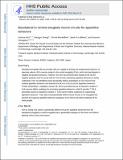Basolateral to Central Amygdala Neural Circuits for Appetitive Behaviors
Author(s)
Kim, Joshua; Zhang, Xiangyu; Muralidhar, Shruti; LeBlanc, Sarah Anne; Tonegawa, Susumu
Downloadnihms863904.pdf (3.348Mb)
PUBLISHER_CC
Publisher with Creative Commons License
Creative Commons Attribution
Terms of use
Metadata
Show full item recordAbstract
Basolateral amygdala (BLA) principal cells are capable of driving and antagonizing behaviors of opposing valence. BLA neurons project to the central amygdala (CeA), which also participates in negative and positive behaviors. However, the CeA has primarily been studied as the site for negative behaviors, and the causal role for CeA circuits underlying appetitive behaviors is poorly understood. Here, we identify several genetically distinct populations of CeA neurons that mediate appetitive behaviors and dissect the BLA-to-CeA circuit for appetitive behaviors. Protein phosphatase 1 regulatory subunit 1B⁺ BLA pyramidal neurons to dopamine receptor 1⁺ CeA neurons define a pathway for promoting appetitive behaviors, while R-spondin 2⁺ BLA pyramidal neurons to dopamine receptor 2⁺ CeA neurons define a pathway for suppressing appetitive behaviors. These data reveal genetically defined neural circuits in the amygdala that promote and suppress appetitive behaviors analogous to the direct and indirect pathways of the basal ganglia. Keywords:
central amygdala; basolateral amygdala; direct and indirect pathways; appetitive; reward; fear; amygdala circuit; feeding; drinking; freezing
Date issued
2017-03Department
Massachusetts Institute of Technology. Department of Biology; Massachusetts Institute of Technology. Department of Brain and Cognitive Sciences; Picower Institute for Learning and MemoryJournal
Neuron
Publisher
Elsevier BV
Citation
Kim, Joshua et al. “Basolateral to Central Amygdala Neural Circuits for Appetitive Behaviors.” Neuron 93, 6 (March 2017): 1464–1479 © 2017 Elsevier Inc
Version: Author's final manuscript
ISSN
0896-6273
1097-4199